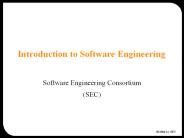Chapter 13 Section 1b: The Science of Rockets - PowerPoint PPT Presentation
Title:
Chapter 13 Section 1b: The Science of Rockets
Description:
Thrust depends on the mass of the gases and the speed of the gases coming out the rocket engine. ... (fuel + oxidizer) Liquid fuel (fuel + oxygen) ... – PowerPoint PPT presentation
Number of Views:173
Avg rating:3.0/5.0
Title: Chapter 13 Section 1b: The Science of Rockets
1
Chapter 13 Section 1bThe Science of Rockets
- How does a rocket work?
- What is the main advantage of a multistage rocket?
2
Newtons Third Law of Motion
- If one object exerts a force on another object
- then the second object exerts a force of equal
strength in the opposite direction on the first
object.
Ball
Head
3
Action-Reaction Pair
- When the dog leaps, it pushes down on the ground
(action force) - The ground pushes the dog into the air (reaction
force)
4
Action-Reaction Pair
Action on the wall
- When a skateboarder pushes against a wall (action
force) - The wall pushes the skater in the opposite
direction (reaction force)
motion
Reaction on the skater
5
How Do Rockets Work?
- A rocket moves forward when gases shooting out
the back of the rocket push it in the opposite
direction.
6
Escaping Earths Gravity
- In order for a rocket to move out of Earths
gravity it must achieve a certain velocity called
escape velocity. - In order for a rocket to go into orbit around the
Earth it must achieve orbital velocity. - Which must be greaterorbital velocity or escape
velocity? - How can scientists calculate the needed thrust to
achieve the correct velocities?
7
Thrust
- Thrust is the reaction force that propels the
rocket forward. - Thrust depends on the mass of the gases and the
speed of the gases coming out the rocket engine.
Fma - To calculate the amount of thrust needed
scientists use Newtons second law. - Force (thrust) mass x acceleration
8
Rocket Fuels
- Three types of rocket fuel are used
- Solid fuel (fuel oxidizer)
- Liquid fuel (fuel oxygen)
- Electrically charged gas (ions)
9
Rocket Altitude
- A rockets altitude is how high it is above the
ground. Use the graph to answer the following
questions about how a model rockets altitude
changes over time.
10
Rocket Altitude
- Reading Graphs
- What two variables are being graphed? In what
unit is each measured?
- Altitude and time, meters and seconds
11
Rocket Altitude
- Reading Graphs
- What was the rockets altitude after 2 seconds?
After 4 seconds?
- About 65 meters about 128 meters
12
Rocket Altitude
- Reading Graphs
- At what time did the rocket reach its greatest
altitude?
- 6 seconds
13
Rocket Altitude
- Inferring
- Why do you think the rocket continued to rise
after it ran out of fuel?
- The rockets inertia caused it to continue to
rise after its fuel ran out. Eventually friction
caused the rocket to slow down and gravity caused
it to fall
14
A Multistage Rocket
- A typical multistage rocket has three stages.
Each of the first two stages burns all of its
fuel and then drops off. The next stage then
takes over.
15
End of SectionThe Science of Rockets































